Abstract
Plasmid DNA vaccination is a promising vaccine platform for prevention and treatment of infectious disease. Enhancement of the DNA vaccine potency by co-inoculation of immunoadjuvant has been shown to be an effective strategy. Modulation of dendritic cells and T-cells locomotion and trafficking to prime an immune response is mediated by distinct chemokines. The recent study was designed to elucidate the adjuvant activity of plasmid expressing CC-chemokine ligand 20 (pCCL20) in co-inoculation with hepatitis C virus (HCV) core DNA vaccine immunization. pCCL20 was constructed and evaluated for its functional expression. Sub-cutaneous inoculation of pCCL20 with HCV core DNA vaccine was performed via electroporation in BALB/c mice on day 0 and 14 and a HCV core protein booster was applied on day 28. On week after final immunization, both humoral and cell-mediated immune responses were assessed by indirect ELISA for core specific antibodies, lymphocyte proliferation, cytokine ELISA/ELISpot and cytotoxic Grenzyme B (GrzB) release assays. Mice were co-immunized with pCCL20 developed higher levels of core specific IFN-γ/IL-4 ratio and IL-2 release, IFN-γ producing cells, lymphocyte proliferation and cytotoxic Grenzyme B release in both draining lymph nodes and spleen cells of immunized mice. The core-specific serum total IgG and IgG2a/IgG1 ratio were significantly higher when the pCCL20 was co-inoculated. These results suggest the potential of CCL20 chemokine as vaccine adjuvant to enhance Th1 mediated cellular and humoral immune responses in HCV core DNA immunization.





Similar content being viewed by others
References
Hajarizadeh B, Grebely J, Dore GJ (2013) Epidemiology and natural history of HCV infection. Nat Rev Gastroenterol Hepatol 10:553–562
Kim CW, Chang KM (2013) Hepatitis C virus: virology and life cycle. Clin Mol Hepatol 19:17–25
Pol S, Vallet-Pichard A, Corouge M, Mallet VO (2012) Hepatitis C: epidemiology, diagnosis, natural history and therapy. Contrib Nephrol 176:1–9
Pol S, Corouge M, Mallet V, Sogni P (2013) Rapid progression of antiviral treatments of chronic hepatitis C virus infection. Minerva Gastroenterol Dietol 59:161–172
Pockros PJ (2010) New direct-acting antivirals in the development for hepatitis C virus infection. Therap Adv Gastroenterol 3:191–202
Roohvand F, Kossari N (2011) Advances in hepatitis C virus vaccines, Part one: advances in basic knowledge for hepatitis C virus vaccine design. Expert Opin Ther Pat 21:1811–1830
Klenerman P, Thimme R (2012) T cell responses in hepatitis C: the good, the bad and the unconventional. Gut 61:1226–1234
Houghton M, Abrignani S (2005) Prospects for a vaccine against the hepatitis C virus. Nature 436:961–966
Weiner DB, Sardesai NY, Schmaljohn C (2010) Introduction to DNA vaccines—Las Vegas. Vaccine 28:1893–1896
Pavio N, Lai MM (2003) The hepatitis C virus persistence: How to evade the immune system? J Biosci 28:287–304
Ferrari C, Valli A, Galati L, Penna A, Scaccaglia P et al (1994) T-cell response to structural and nonstructural hepatitis C virus antigens in persistent and self-limited hepatitis C virus infections. Hepatology 19:286–295
McLauchlan J (2000) Properties of the hepatitis C virus core protein: a structural protein that modulates cellular processes. J Viral Hepat 7:2–14
Hartoonian C, Ebtekar M, Soleimanjahi H, Karami A, Mahdavi M et al (2009) Effect of immunological adjuvants: GM-CSF (granulocyte-monocyte colony stimulating factor) and IL-23 (interleukin-23) on immune responses generated against hepatitis C virus core DNA vaccine. Cytokine 46:43–50
Matsui M, Moriya O, Belladonna ML, Kamiya S, Lemonnier FA et al (2004) Adjuvant activities of novel cytokines, interleukin-23 (IL-23) and IL-27, for induction of hepatitis C virus-specific cytotoxic T lymphocytes in HLA-A*0201 transgenic mice. J Virol 78:9093–9104
Alekseeva E, Sominskaya I, Skrastina D, Egorova I, Starodubova E et al (2009) Enhancement of the expression of HCV core gene does not enhance core-specific immune response in DNA immunization: advantages of the heterologous DNA prime, protein boost immunization regimen. Genet Vaccines Ther 7:7
Hu GJ, Wang RY, Han DS, Alter HJ, Shih JW (1999) Characterization of the humoral and cellular immune responses against hepatitis C virus core induced by DNA-based immunization. Vaccine 17:3160–3170
Geissler M, Gesien A, Tokushige K, Wands JR (1997) Enhancement of cellular and humoral immune responses to hepatitis C virus core protein using DNA-based vaccines augmented with cytokine-expressing plasmids. J Immunol 158:1231–1237
Tsen SW, Paik AH, Hung CF, Wu TC (2007) Enhancing DNA vaccine potency by modifying the properties of antigen-presenting cells. Expert Rev Vaccines 6:227–239
Guermonprez P, Valladeau J, Zitvogel L, Thery C, Amigorena S (2002) Antigen presentation and T cell stimulation by dendritic cells. Annu Rev Immunol 20:621–667
McKay PF, Barouch DH, Santra S, Sumida SM, Jackson SS et al (2004) Recruitment of different subsets of antigen-presenting cells selectively modulates DNA vaccine-elicited CD4+ and CD8+ T lymphocyte responses. Eur J Immunol 34:1011–1020
Rossi DL, Vicari AP, Franz-Bacon K, McClanahan TK, Zlotnik A (1997) Identification through bioinformatics of two new macrophage proinflammatory human chemokines: MIP-3alpha and MIP-3beta. J Immunol 158:1033–1036
Liao F, Rabin RL, Smith CS, Sharma G, Nutman TB et al (1999) CC-chemokine receptor 6 is expressed on diverse memory subsets of T cells and determines responsiveness to macrophage inflammatory protein 3 alpha. J Immunol 162:186–194
Imaizumi Y, Sugita S, Yamamoto K, Imanishi D, Kohno T et al (2002) Human T cell leukemia virus type-I Tax activates human macrophage inflammatory protein-3 alpha/CCL20 gene transcription via the NF-kappa B pathway. Int Immunol 14:147–155
Roohvand F, Aghasadeghi MR, Sadat SM, Budkowska A, Khabiri AR (2007) HCV core protein immunization with Montanide/CpG elicits strong Th1/Th2 and long-lived CTL responses. Biochem Biophys Res Commun 354:641–649
Lohr HF, Schmitz D, Arenz M, Weyer S, Gerken G et al (1999) The viral clearance in interferon-treated chronic hepatitis C is associated with increased cytotoxic T cell frequencies. J Hepatol 31:407–415
Thimme R, Oldach D, Chang KM, Steiger C, Ray SC et al (2001) Determinants of viral clearance and persistence during acute hepatitis C virus infection. J Exp Med 194:1395–1406
Razavi H, Elkhoury AC, Elbasha E, Estes C, Pasini K et al (2013) Chronic hepatitis C virus (HCV) disease burden and cost in the United States. Hepatology 57:2164–2170
De Francesco R, Migliaccio G (2005) Challenges and successes in developing new therapies for hepatitis C. Nature 436:953–960
Halliday J, Klenerman P, Barnes E (2011) Vaccination for hepatitis C virus: closing in on an evasive target. Expert Rev Vaccines 10:659–672
Kathuria N, Kraynyak KA, Carnathan D, Betts M, Weiner DB et al (2012) Generation of antigen-specific immunity following systemic immunization with DNA vaccine encoding CCL25 chemokine immunoadjuvant. Hum Vaccin Immunother 8:1607–1619
Xu R, Megati S, Roopchand V, Luckay A, Masood A et al (2008) Comparative ability of various plasmid-based cytokines and chemokines to adjuvant the activity of HIV plasmid DNA vaccines. Vaccine 26:4819–4829
Sin J, Kim JJ, Pachuk C, Satishchandran C, Weiner DB (2000) DNA vaccines encoding interleukin-8 and RANTES enhance antigen-specific Th1-type CD4(+) T-cell-mediated protective immunity against herpes simplex virus type 2 in vivo. J Virol 74:11173–11180
Kim JJ, Yang JS, Dentchev T, Dang K, Weiner DB (2000) Chemokine gene adjuvants can modulate immune responses induced by DNA vaccines. J Interferon Cytokine Res 20:487–498
Song R, Liu S, Leong KW (2007) Effects of MIP-1 alpha, MIP-3 alpha, and MIP-3 beta on the induction of HIV Gag-specific immune response with DNA vaccines. Mol Ther 15:1007–1015
Biragyn A, Schiavo R, Olkhanud P, Sumitomo K, King A et al (2007) Tumor-associated embryonic antigen-expressing vaccines that target CCR6 elicit potent CD8+ T cell-mediated protective and therapeutic antitumor immunity. J Immunol 179:1381–1388
Chavan R, Marfatia KA, An IC, Garber DA, Feinberg MB (2006) Expression of CCL20 and granulocyte-macrophage colony-stimulating factor, but not Flt3-L, from modified vaccinia virus ankara enhances antiviral cellular and humoral immune responses. J Virol 80:7676–7687
Guo JH, Fan MW, Sun JH, Jia R (2009) Fusion of antigen to chemokine CCL20 or CXCL13 strategy to enhance DNA vaccine potency. Int Immunopharmacol 9:925–930
Fushimi T, Kojima A, Moore MA, Crystal RG (2000) Macrophage inflammatory protein 3α transgene attracts dendritic cells to established murine tumors and suppresses tumor growth. J Clin Invest 105:1383–1393
Igoucheva O, Grazzini M, Pidich A, Kemp DM, Larijani M et al (2013) Immunotargeting and eradication of orthotopic melanoma using a chemokine-enhanced DNA vaccine. Gene Ther 20(9):939–948
Acknowledgments
We thank Dr. Mahsa Rasekhian and Dr. S.M. Hossein Etemadzadeh for their technical assistance. Financial support was provided by Faculty of Pharmacy, Tehran University of Medical Sciences and partly was supported by Grants of Virology Department of Pasteur Institute of Iran.
Conflict of interest
The authors declare any conflict of interest and financial disclosure.
Author information
Authors and Affiliations
Corresponding author
Rights and permissions
About this article
Cite this article
Hartoonian, C., Sepehrizadeh, Z., Mahdavi, M. et al. Modulation of hepatitis C virus core DNA vaccine immune responses by co-immunization with CC-chemokine ligand 20 (CCL20) gene as immunoadjuvant. Mol Biol Rep 41, 5943–5952 (2014). https://doi.org/10.1007/s11033-014-3470-5
Received:
Accepted:
Published:
Issue Date:
DOI: https://doi.org/10.1007/s11033-014-3470-5




